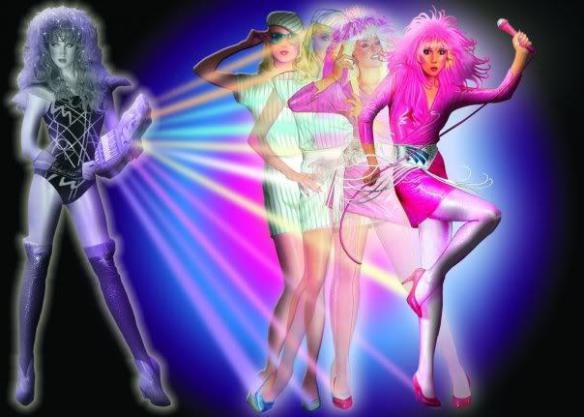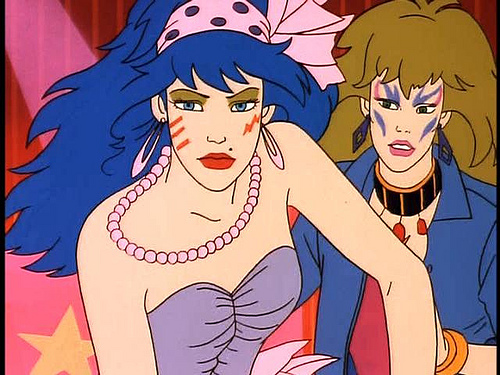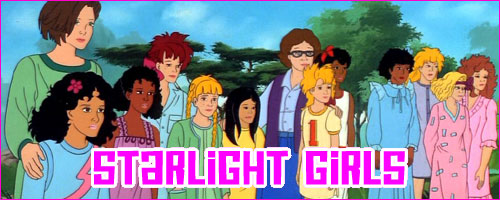As a little girl growing up in the 80s, I loved the show Jem & the Holograms. I confess that I still have a bunch of the songs from the show that I listen to from time to time (occasionally subjecting my spin class attendees to a Jem track on my workout playlists). Looking back now as an adult feminist, I’ve wondered how the show influenced me and whether or not that influence was a positive thing. *I did a similar assessment of another of my much-loved 80’s cartoons called: She-Ra Kinda Sorta Accidentally Feministy.*
There are a few potential not-necessarily-empowering aspects of Jem. Firstly, the show is fashion-obsessed and revolves around the characters’ fashionability. Unlike most cartoons where the characters mostly wear the same outfit in every episode, the thin female bodies of Jem‘s characters are adorned in multiple wardrobe changes often within a single 20-minute episode. Fashion and modeling, we know, are traditionally coded as female. The fashion world is extremely hard on women, placing undue emphasis on their bodies, especially on the thinness of those bodies. The drummer (and Black bandmate) Shana, however, designs clothing, so there is an aspect of fun creative expression at play here. Not only that, but the band Jem & the Holograms gets into the world of fashion and music in order to maintain the foster home for young girls that they run.
In this light, being on the cutting-edge of fashion, making money, being famous, and maintaining their record label (Starlight Music) is all a means to a philanthropic ends. The band often performs benefit concerts, singing many songs that deliver a positive message about fair play, hard work, creativity, education, and friendship to its young, predominately female audience. Jerrica Benton (Jem’s alter ego) must become a savvy business woman in the advent of her father’s death in order to run her inherited huge record label while living with her beloved foster girls, trying to give them good, happy lives. Jerrica and her friends are capable, ambitious women who thrive in the business world and do so for noble reasons. That type of female representation is all too rare in any pop culture medium, and it definitely had a positive effect on my impressionable younger self.
Another aspect of the show that could be a negative for little girls was all the female rivalry. The primary focus of the show was the often high-stakes band rivalry between Jem & the Holograms and their nemeses (another all-female band), The Misfits.

The Misfits were mean, reckless, and ruthless in their pursuit to beat Jem at everything. They’d lie, cheat, commit crimes and sabotage, and endanger the lives of Jem and her bandmates in order to win at any cost. They even had a song called “Winning is Everything.” True story.
[youtube_sc url=”http://www.youtube.com/watch?v=CMlneySmI3g”]
Though Jem passes the Bechdel Test with flying colors, this dangerous female rivalry is troubling, reinforcing mainstream media’s insistence that women can’t be friends; they must, instead, compete for resources, men, and general approval. Instead of the bands being able to cooperate and collaborate, they are mostly at each other’s throats (with The Misfits, of course, being the instigators). The upside of this rivalry is that the major players are all women. The characters with all the talent, power, and agency are women. The epitome of this is the all-powerful matriarchal figure of Synergy. She’s a basically sentient hologram generating computer system. She gets Jem and her crew out of countless jams, operates as home base for their operations, and acts as a concerned, maternal mentor for them. Though Synergy is a computer system, she has awesome power and Jerrica/Jem often goes to her for counsel.

Not only that, but even the cruel Misfits are given depth over time. My favorite character (on whom I had a serious girl-crush) was Stormer, the blue-haired Misfit who was a bad girl with a heart of gold. When her bandmates crossed the line, she would always undermine their machinations in order to do the right thing, often saving the day. We also learn that Pizazz, the ringleader and front woman for the band, struggles with her former identity as: Phyllis, a rich girl with a neglectful father whose approval and attentiveness she could never garner. Despite the contentiousness of the rival bands’ relations, the fact that women are the primary actors and reactors gives the show a variety of female perspectives and permutations, which is what’s so often lacking in current female representations in film and on TV.

In fact, there are hardly any male characters in the show at all. There are only two to speak of: Jem/Jerrica’s love interest and road manager, Rio Pacheco, and The Misfits’ slimy band manager, Eric Raymond. Later the lead singer of The Stingers, Riot, enters the scene with his ridiculous hair and obsession with Jem. These male characters’ relevance and even usefulness was often in question. Eric was incompetent at all of his scheming in a distinctly Road Runner style. Jem/Jerrica couldn’t even confide her secrets in Rio, and he was often left waiting in the dark for situational resolutions. I often questioned how healthy for young girls the representation of the love triangle involving Rio, Jem, and Jerrica was. It was bizarre that Jem was Jerrica, so Rio was essentially cheating on his girlfriend…with his girlfriend. There was even an episode where Jerrica gets tired of being herself and her Jem personae, so she dons a hologram of a completely new appearance. Rio falls in love with her, too, and they share a kiss. Though the inherent deception on all sides of the relationship is not good role modeling, maybe it’s important that Rio loves Jerrica no matter what physical form she takes on.

The band itself, Jem & the Holograms, was also surprisingly racially diverse. The drummer, Shana, was Black, and the lead guitarist, Aja, was Asian. They later added a new drummer, Raya, who was Latina, when Shana took up bass guitar. Though the front woman for the band (who couldn’t actually play an instrument) remained a white woman, with the addition of Raya, there were actually more women of color in the band than white women. I don’t know if I’ve ever seen that kind of ratio on a TV show that wasn’t specifically targeted at people of color.

Though the show’s focus on romantic love, fashion, and female rivalry are of dubious value, there are definitely a lot of good things going on with Jem & the Holograms: the notion that fame and fortune should be used for philanthropic means, that female friendships can be strong and form an important network of support, that a sense of community is crucial, especially that of an older generation of women actively participating in that of teenage girls, that the arts should be respected and fostered, and that the virtues women should value in themselves should include honesty, compassion, fairness, determination, and kindness. Maybe I’m biased because I always thought the show was “truly outrageous,” but the good seems to outweigh the bad, giving us a series about women that tried to teach little girls how to grow up to be strong, ethical, and believe in themselves.


Earlier today I was watching Jem and it occurred to me how the rivalry between the Holograms and Misfits does play into that whole “women can’t be friends” trope. However, I think you’re right about the good outweighing the bad.
But on the other hand, how often are all male groups rivals to other all male groups? Pretty much always. Ninja turtles vs the foot clan, G.I. Joe vs Cobra, autobots vs decepticons, etc. The Holograms vs The Misfits is a progressive female example of the hero vs their antithesis, and I don’t think it comes close to the “women can’t be friends” trope because it doesn’t pit female groups against each other because they are competition, rather their rivalry stems from their opposing values. It’s a structurally significant difference.
In the pilot episode, when Eric Raymond hires a goon to plant an IED in an orphanage and the Misfits try and run Jem & Co off a cliff…the answer should not be “let’s have a battle of the bands.” I love Jem but I do get a little concerned about the odd reactions to attempted murder. As a feminist, and I admit that I may be reading a lot into this, it feels like yet another contribution to the violence as the norm from the female POV. The love triangle bothered me so much then, and does now (almost Superman level trolling of emotions between the characters) but I am now considering the diversity and that is pretty awesome. I guess it just seemed normal that there would be a diverse set of characters and I hadn’t examined it in light of the fact that I now know that it is not normal for mainstream media to have diverse characters.
Later in episode 64 Jem has fallen in love with Riot I am base in this fact her Jem trying to kiss Riot by taking his face in her hands and also because of what Kimber says to Jem on their ride up and she blushes and when they get off Kimber tells Jem to kiss Riot for her too. Jem stays up all night with Riot talking even through she is suppose to have a boyfriend and if you take a look at the other episodes she never did this with her boyfriend. I get that she help Riot reunited with his father and that was good of her to do. But if look in the finial episode you see that she go gives Riot a kiss the cheek (when she tells the holograms that he (I mean Riot) will not help Jerica but he will help Jem) what is meaning behind that. When BaNee is kidnapped Jem leans on Rio for comfort what is meaning to that.
When I was a young girl I watching Jem and the Holograms. I had a crush on Rio because he was so devoted to Jem he loved her so deeply that he was willing to give her up so she can Riot and the stringers to a contract but she realize just how much Rio love her and how much she love him and she couldn’t bear to lose Rio for anything and Riot realize this that is how come I can’t understand how Jem can go from loving Rio to falling in love with Riot. But in another episode Jerrica herself says that Riot may not help Jerrica but he will help Jem and she changes into Jem and off she go to Riot’s apartment, she asks Riot for his help to help her find Ba Née’s father and tells yes he will help her and Jem kiss him on his cheek and he walks her to the door and he tells her that he will want a real kiss when she realize how truly wonderful he really is. Jem turn to Rio when Ba Née is kidnap and she is upset why wasn’t Riot there if she suppose to be in love with him, but instead it is Rio. Later at Ba Née farewell party Rio is sitting on the sofa with his arm around Lindsay and talking to Minx, Jem is giving Ba Née a farewell present and Riot is standing right next to her and tells her Jem about that kiss Jem glances out of the side of her eye and sees something that she didn’t like because her eyes widen and then they go small and widen again when she acknowledges Riot tells him yes about that kiss you will get your kiss from Ba Née why didn’t she kiss Riot in front of everyone and that includes Rio if she is suppose to be in love with Riot now. Could it be that she knew what he was up to by trying to tell every that Jem is in love him and Rio and he was hoping that Jem will want to do this by acknowledging that Jem and him are a couple now. But that is not how it play out so I asked Could we say from this that Jem is still in love with Rio or did she did this so she will not hurt Rio feelings.
With regard to the female rivalry, I don’t see it as specifically female. Though spelling as hetero white man and all that, I think it was just the series needed antagonists to fit with the style of the time and the cast was to be mostly female so by default the misfits are female. There’s always ways a rivalry, even if between genders, can be viewed as harmful.
But anyway you do say the guys outweighs the bad overall which it clearly does I think. Looking back now I think maybe these good ideals of cartoons have influenced me to be a good person (I at least like to believe I’m one) even though the moralising is much scoffed at.
Loved the style and fashion aspect and that’s possibly had an affect on me too..